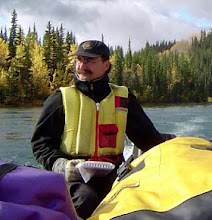 |
| The confluence of the White and Yukon Rivers. |
About 160 years ago the first Euro-Canadian newcomers entered the upper Yukon basin looking for furs. And aside from a couple of exceptions - the Klondike Gold Rush 1897-1899, the construction of the Alaska Highway in WWII and post-war mining booms, few others have followed. Today the Yukon Territory is home to almost 36,000 people, both First Nation and Newcomers. The Yukon, although 1/3 larger than Germany, has a population of 81,823,000 less people. The Yukon is considered lightly populated.
This small population is largely centered in the capital, Whitehorse (27,300) with 13 towns and villages scattered through the rest of the territory. One interesting feature of this low density of population is the almost complete absence of private property holdings outside the small area comprising these 14 communities. The bulk of the land is held by government - national, territorial and First Nation - and is mostly empty of people.
 |
| Several forest fires have swept through the middle Yukon River valley in the past ten years. |
|
|
|
|
There has never been a comprehensive plan for the development of the territory. In many ways the North in Canada was seen as an open resource frontier. Mineral claims, timber leases and protected areas have been carved out of the territory to meet various economic and social needs, rarely with much thought about the future.
With settlement of a treaty between Canada and Yukon First Nations this situation has been changed. The Agreement, finalized in 1990, lays out a program of regional land use planning to ensure that thoughtful and community sensitive developments take place in the future. There is a territorial Land Use Planning Council to support regional bodies undertaking the plans. And slowly the plans are being worked on. A plan for the Yukon North Slope has been completed, a second is currently mired in controversy, while a third, for the Dawson Region along the Yukon River, is just getting underway.
Recently I was invited to join this third planning group on an investigative trip along the Yukon River.
 |
| The Minto mine has begun production and uses this barge to get its ore trucks across the Yukon River and down the highway to Skagway, Alaska for shipment out to refiners. |
Recently heavy mining activity along the river valley has been sparked by high gold and base metal prices. There are no roads in much of the area of interest so everything is brought in either by plane or by river barge. The Yukon River hasn't been this busy since the river boats stopped operating in the early 1950s when the still basic road network was completed.
In the course of our three day trip we saw four large barges supplying the isolated prospecting and mining camps. They are hauling lumber for camp construction and supplies but the largest loads are diesel fuel for equipment and electricity production. One ore body currently under development will require a power plant delivering more electricity than the territory's three hydro-electric dams and remote diesel generators now generate. See the Yukon Conservation Society's dynamic graphic showing the mineral staking rush between 2009 and 2011. There are some major changes coming up soon.
 |
| Cowboy Smith's barge just below Minto hauling propane and diesel fuel to remote mining and prospecting camps. |
 |
| Smith's barge continuing on upstream. |
The river also holds recreational values and an important international tourist experience. It is a popular canoe trip for both locals and visitors from around the world. On our family's river trips over the years we've met paddlers from Germany France, Britain, Japan and many other countries. The trip between Whitehorse and Dawson takes about two weeks with camping on sand bars, historic Fort Selkirk and old wood camp and roadhouse sites.
 |
| The bluff across the river from Fort Selkirk. |
 |
| The river was high so paddlers have been moving swiftly downstream this summer. |
 |
| A cabin at Fort Selkirk. |
 |
| Fort Selkirk is co-owned and managed by the Selkirk First Nation and the Yukon Government. |
The river maintains an ecological integrity of great value. Hunting and fishing remain important First Nation cultural and subsistence practices. While well paying jobs in industrial development are welcome Yukon communities remain conscious of the importance of the natural world they live in.
 |
| Moose cow and calf on the river bank. |
 |
| Storm clouds hang on the hills overlooking the river valley. |
















